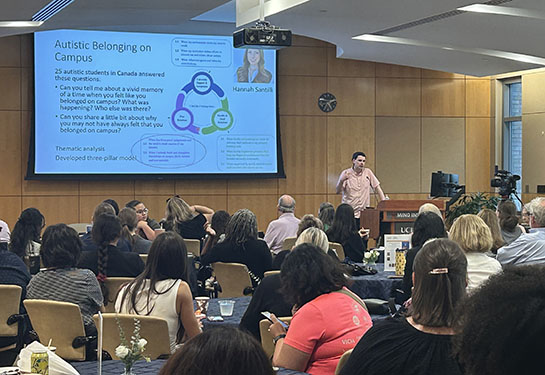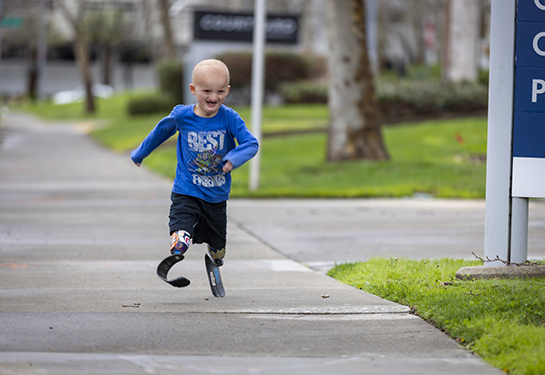Reports provided by caregivers via telehealth a good alternative to in-person developmental assessments
New findings may help improve access to autism assessments
A study by UC Davis Health and Vanderbilt University Medical Center has found that developmental assessments for autism performed through telehealth may be a good alternative to in-person evaluations. The research, published in the Journal of Autism and Developmental Disorders, could have important implications for increasing access to autism screenings.
The team compared caregiver reports provided on telehealth via the Developmental Profile, 4th Edition, to an in-person developmental test, the Mullen Scales of Early Learning. They found a high degree of correlation between the two.
The UC Davis MIND Institute’s Sally Ozonoff, professor in the Department of Psychiatry and Behavioral Sciences, was the lead author on the study. In this Q&A, she explains the importance of the finding for clinicians.
What were you testing in this study?
There are two components of a diagnostic autism evaluation. One is assessing for autism and the other is assessing development in general (for example, communication, motor and cognitive skills). During in-person evaluations, the developmental assessment is completed by a psychologist or other examiner. But in a telehealth assessment, this developmental portion relies on information from parents or other caregivers. Our goal was to see how accurate the parent-reporting tool was when compared to the in-person assessment. We were originally looking to create a new tool for this purpose, but then we discovered that this already-existing instrument — the Developmental Profile, 4th Edition — was very accurate.
What is the Developmental Profile, 4th Edition?
It’s a tool that comes in both a questionnaire and an interview format. It is commonly used by psychologists and others who evaluate young children. We used the interview version in this study. Parents are asked questions about their child’s development, such as, ‘Can your child stack four blocks, or take off a shirt without help, or point to body parts?’ This instrument is often used when time is limited, because an in-person developmental test is lengthy and can take an hour or more. Use of the interview increased in telehealth evaluations during the COVID pandemic. We wanted to see if it was doing a good job capturing the child’s developmental strengths and any challenges they might be having.
How did the study work?
In a study being done at UC Davis Health and Vanderbilt University Medical Center, we looked at 93 children ages 18-42 months, who were being evaluated for autism. Caregivers were interviewed with the Developmental Profile, 4th Edition via telehealth. Then the children were tested in person about two weeks later using the Mullen Scales of Early Learning.
What were the key findings?
There were strong correlations between the in-person evaluations and the parent-reported interview done via telehealth. Even more importantly, almost all the time that the in-person testing indicated that a child’s development fell below average, the parent interview also indicated this. For example, in the communication domain, only 10% of children were classified as below average through direct testing, but average in the caregiver report. This is very reassuring that most children (90%) would meet the same eligibility criteria for speech therapy services whether they were tested in person using the Mullen Scales of Early Learning or via telehealth using the Developmental Profile, 4th Edition.
Ultimately, we want more children to get the services they need. So, it is important that we showed that telehealth measurement of general development is accurate.” —Sally Ozonoff, Professor, Department of Psychiatry and Behavioral Sciences
What are the implications of your findings?
We hope this will help address issues of equity and access in autism evaluations. Telehealth assessments may be easier for people living in rural areas or in places where there aren’t many specialists. Ultimately, we want more children to get the services they need. So, it is important that we showed that telehealth measurement of general development is accurate.
One caveat is that this finding only applies to children ages 3-1/2 and younger. Also, if a child doesn’t have autism and further testing is needed for possible global developmental delay, or intellectual disability, a parent interview alone would not be enough — direct testing in person would be recommended. But within the context of an autism evaluation, this parent interview does appear to be very effective at helping us determine what additional services they need to more broadly support all areas of their development.
Co-authors on the study include Devon Gangi, Monique Moore Hill, Shyeena Maqbook, Rachel Ni and Chandni Parikh of UC Davis; and Laura Corona, Tori Foster, Makayla Honaker, Amy Nicholson, Caitlin Stone, Anna Kathleen Spitler, Amy Swanson, Alison Vehorn, Liliana Wagner, Amy Weitlauf and Zachary Warren of Vanderbilt University.
The UC Davis MIND Institute in Sacramento, Calif. was founded in 1998 as a unique interdisciplinary research center where families, community leaders, researchers, clinicians and volunteers work together toward a common goal: researching causes, treatments and potential prevention of challenges associated with neurodevelopmental disabilities. The institute has major research efforts in autism, fragile X syndrome, chromosome 22q11.2 deletion syndrome, attention-deficit/hyperactivity disorder (ADHD) and Down syndrome. More information about the institute and its Distinguished Lecturer Series, including previous presentations in this series, is available on the Web at mindinstitute.ucdavis.edu.





